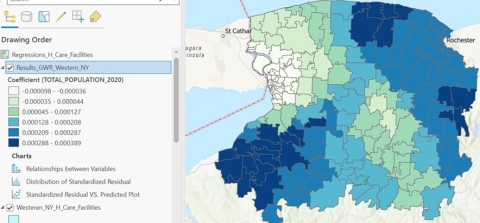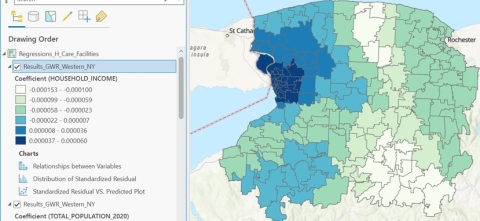
Professor Tang's research and teaching interests are Geographic Information Systems and Science (GIS), Remote Sensing, Physical and Environmental Geography, Slope form and processes. GIS applications in land use planning, environmental modeling, watershed management, and GIS applications in K-12 education.
He teaches courses in GIS, remote sensing, map interpretation, physical geography, and the geography of Asia.



Selected recent publications | Published reports
Selected recent publications
Fundamentals of Geographic Information Systems (GIS) Analysis: Applying ArcGIS Pro. Tao Tang, ISBN: 978-1-394-25217-6, August 2025, Wiley-IEEE Press, 560 pages.
Tang, T., H. T. Fan, Q. Sun, W. J. Zhao. 2023. Spatial and Temporal Analysis of Daily Measurements of PM2.5 Air Pollution in Beijing, China. Journal of Geography and Earth Sciences, 11(1), pp. 1-42. http://jgesnet.com/vol-11-no-1-june-2023-current-issue-jges
Tang, T., M. Radomski, M. Stefan , M. Perrelli and H. T. Fan, 2020. UAV-based high spatial and temporal resolution monitoring and mapping of surface moisture status in a vineyard. Journal of Papers in Applied Geography. Vol. 6, Issue: 6. https://www.tandfonline.com/doi/full/10.1080/23754931.2020.1798808
Tang, T., L. Jiang and M. Perrelli, 2020. Data Collection and Analyses Applying Unmanned Helicopter (UAV) Remote Sensing to Survey Water Chestnut Invasive Species. International Journal of Data Analytics, Volume 1, Issue 1, January-June 2020, Page: 38-51.
Tang, T., L. Jiang, and M. Perrelli. 2019. Low-altitude unmanned helicopter (UAV) remote sensing for spreading control of water chestnut invasive species in the Erie Canal System, New York, Middle States Geographer, Vol. 52, in press.
Tang, T. and J. Zhang. 2018. Time scale sensitive sensor applications in collecting and analyzing geographic event data. Annals of Geographic Information Science (GIS), Taylor and Francis Publisher: https://doi.org/10.1080/19475683.2018.1520299, Vol. 24 No. 4: 241-253.
Gao, Y., R. F. Zhong, T. Tang, L. Z. Wang, and X. L. Liu, 2017. “Automatic extractions of pavement markings on streets from point cloud data of mobile LiDAR”. Measurement Science and Technology, IOP Science Publishing Inc. Vol. 28, No. 8. 1088-1101.
Gong, H. L. Tang, T., Gong, Z. N., Li, X J., Chen, Y Z., and W. J. Zhao. 2015. Spatial and temporal trend of water resources in Beijing, China during 1999-2012 and its impact analysis. British Journal of Environment and Climate Change. Vol.5(2): 176-188.
Xiong, Q. L., W. J. Zhao, Z. N. Gong, W. H. Zhao, and T. Tang. 2015. Fine Particulate Matter Pollution and Hospital Admissions for Respiratory Diseases during Heating Period in Beijing,China . International Journal of Environmental Research and Public Health, 12(9), 11880-11892; doi: 10.3390/ijerph120911880.
Tang T. and L. Dai, 2014. Accuracy test of point based and object based building feature classification and extraction applying airborne LiDAR data. Journal of Geocarto International. 2014 (Online 2013), Volume 29, Issue 7, pages 710-730
Zhang J. Z. and Tang T. (correspondent author), 2014. Spatial and Temporal Changes of Parking Lot Land Use at SUNY - Buffalo State Applying Unmanned Helicopter Remote Sensing. Middle States Geographer, Volume 47, 92 – 101
Tang T., W. Zhao, H. Gong, X. Li, K. Zang, W. H. Zhao, Bernosky J. D., and S. Li, 2010. GIS Spatial Analysis of Population Exposure to Fine Particulate Air Pollution in Beijing, China. Environmental Geosciences. Volume 17, Issue 1: 1-16.
Tang T. and C. Anderson, 2010. Spatial Statistical Modeling of the Pollution Impact of Old Industrial Sites on Colon and Lung Cancer Incidents in New York State, USA. IEEE (The Institute of Electrical and Electronic Engineers) Proceedings – Geoinformatics. IEEE Xplore: Issue 15, In press.
Tang T., X. Wang, Z. Shi, and J. Carbonara, 2009. Feature Shape and Elevation based Road Classification and Extraction on High Spatial Resolution Remote Sensing Imageries, IEEE Proceedings -– Geoinformatics. IEEE Xplore: Issue 12-14, Page(s):1 - 6
Tang, T., W. H. Zhao, W. Zhao, H. Gong, and L. Cai, 2009. GIS Analysis of Spatial and Temporal Changes of Air Particulate Concentrations and Their Impacts on Respiratory Diseases in Beijing, China. Middle States Geographer, 42: 73-82
Tang T., W. Zhao, H. Gong, A. Zhang, J. G. Pan, and Z. Q. Liu, 2008. Terrestrial Laser Scan (LiDAR) Survey and 3D TIN Model Construction of Urban Buildings in a Geospatial Database. Geocarto International. Taylor and Francis Inc., Publisher. Volume 23, Issue 4: 259-272. http://www.informaworld.com/smpp/content~content=a791490594~db=all~order=page
Tang T. and G. Keyser, 2008. Spatial Analysis of Household Water Supply and Demand in a Distributed Geographic Network in the Towns of Amherst and Clarence, New York. Middle States Geographer, 40: 133-141.
Zhao, W., *Tang T., Gong H., Duan F. S., and Y. Mo, 2006. Dynamic Data Retrieval and Distance Decay of Triangulated Irregular Network (TIN) in Three Dimensional Visualizations, Geographic Information Sciences, Vol. 12, No.01: 21 - 26 (*correspondence author).
Tang T. and M. Wannemacher, 2005. GIS Simulation and Visualization of Community Evacuation Vulnerability in a Connected Geographic Network Model. Middle States Geographer, 38: 22-30.
Tang, T. 2005. Spatial Analysis of Topological Accuracy for U.S. Census Tiger Type Street Centerlines using Parcel Data. Proceedings of the 4th International Symposium on Spatial Data Quality: 78 – 94.
Tang T. 2005. Spatial Statistic Interpolation of Morphological Factors for Terrain Development. GIScience and Remote Sensing vol.42 (2): 131- 143.
Tang, T. 2003. Combining supervised classification and airphoto interpretation of high spatial resolution satellite imagery for land use analysis. Middle States Geographer (36): 106-112.
Fulton, B. and Tang, T. 2003. Impact of land use zoning on residential values in the Town of Orchard Park, Erie County, New York. The Pennsylvania Geographer (41): 25-44.
Tang,T., Johnson-Gentile, K., and T. Kury, 2003. Implementing Geographic Information Systems (GIS) Technology into K-12 Education to Facilitate Active Learning. National Forum of Applied Educational Research Journal 17(1): 5-22.
Tang, T. 2003. Surface Sediment Characteristics and Tower Karst Dissolution, Guilin, Southern China. Geomorphology , 49(3-4): 231-254.
Day, M.J. and Tang, T. 2003. Tower Karst. Encylopedia of Caves and Karst pp,742-744.
Tang, T. and Irvine, K.N. 2002. GIS Analysis of the Land Use Effect on Water Quality in the Cazenovia Creek Watershed. The Great Lakes Research Review 5(3): 1-11.
Greer, M.J., Irvine, K.N., Tang, T. 2002. Evaluating Ecosystem Integrity in Great Lakes Tributaries. Clearwaters 32 (2): 16-20.
Tang, T. 2001. Slope Profile Analysis and Classification an Limestone Residual Hills in Guilin, China. Middle State Geographer 33: 40-53.
Tang, T. and Day, M.J. 2000. Field Survey and Analysis of Hillslopes on Tower Karst in Guilin, Southern China. Earth Surface Processes and Landforms 25(11): 1221-1235.
Tang, T., Irvine, K.N., Greer, M., and Robinson, R. 1999. GIS Based Assessment of the Impact of Urban Land Use to Suspended Sediment and Water Quality in the Cazenovia Creek Watershed, New York. Middle States Geographer 32: 88-98.
Tang, T. 1998. Field Testing of Rock Hardness and Its Relationship to Limestone Dissolution in Guilin, Southern China. Middle States Geographer 31:15-22.
Book Chapter:
Tang, T., W. Zhao, and H.L. Gong. 2015. Chapter 7 – Spatial Analysis of Air Pollution and Its Impacts on Human Health in Beijing, China. In Applications of Geospatial Information Technologies in Public Health (地理空间信息技术在公共卫生中的应用).
Higher Education Press of China. Page 149-165. In Chinese.
Published Reports
Tang, T. and T. Kury, July, 2000. Proceedings of the workshop on the "Integration of Geographic Information Systems (GIS) and Computer Mapping into the Social Studies Curriculum of the City of Buffalo School System", Department of Geography and Planning, Buffalo State College. 109p.
Tang, T. and K. Johnson-Gentile, August, 1999. Proceedings of the workshop on the "Integration of Geographic Information Systems (GIS) and Computer Mapping into K-12 Education Curriculum", Department of Geography and Planning and Department of Elementary Education and Reading, Buffalo State College. 86p.
Irvine, K., Tang, T., and T. Murphy, March 19, 1999. Summary of conventional parameter, bed sediment, suspended sediment, and meteorological data, Whitewater Lake, Manitoba, Canadian National Water Research Institute, PO Box 5050, 867 Lakeshore Road, Burlington, Ontario, L7R 4A6. 18p.
GIS Reserch and Community Service Internet Mapping Site (Including ArcIMS/Arc Server and Map Server).

